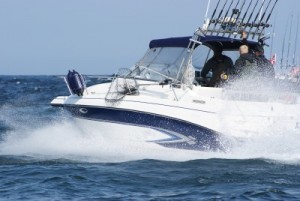 Fish finders are often referred to as depth sounders. This device is essentially a sophisticated timing device. The transducer is actually a crystal enclosed in a housing. The crystal gets notified when energy shows up and gives a slight click of acoustic energy. That short burst of noise is sent to the bottom to reflect back all the life it encounters such as fish, kelp, schools of bait, and plankton. Once it hits the bottom itself, the whole pulse of energy is turned around and sent back up towards the surface. The acoustic energy is converted back to electrical energy and sent to the display where it is modified, analyzed, amplified and instantly converted into the dazzling display of confusing colors that are so instrumental to the enjoyment of our time on the water. The transducer is the most important part of the operation. The options are vast in today’s fish finding market.
Fish finders are often referred to as depth sounders. This device is essentially a sophisticated timing device. The transducer is actually a crystal enclosed in a housing. The crystal gets notified when energy shows up and gives a slight click of acoustic energy. That short burst of noise is sent to the bottom to reflect back all the life it encounters such as fish, kelp, schools of bait, and plankton. Once it hits the bottom itself, the whole pulse of energy is turned around and sent back up towards the surface. The acoustic energy is converted back to electrical energy and sent to the display where it is modified, analyzed, amplified and instantly converted into the dazzling display of confusing colors that are so instrumental to the enjoyment of our time on the water. The transducer is the most important part of the operation. The options are vast in today’s fish finding market.
What should you know about transducers? There are several concepts that you should be familiar with in order to understand effective fish finding. Educate yourself with regards to beam angles and frequencies. If you are standing directly over the location of the transducer that is the perspective it uses to see the world underwater. The energy beams out into a cone shape. The shape the energy takes is called the “beam angle” and helps to determine what is displayed on your screen. The acoustic energy is sent off into the cone-shaped beam at some specific frequency. You’ll see major differences between the different frequencies and this is where things start to get somewhat technical.
The beam angles in the higher frequencies (200 kHz) tend to be very narrow, in the 8- to 12-degree range. This means that if you are standing over your transducer with your meter on, the energy is sent down in a cone shape, about 5 degrees off vertical in any direction. If you are in a 100 feet of water the diameter of the cone on the bottom will be about 10 feet across. All the energy is concentrated and the pulse lengths are short, so you can get extraordinary definition and detail to show what is sitting under the boat. When you see fish being drawn on the screen, they are pretty much directly under the boat. In contrast, the lower frequencies may have very wide beam angles, as much as 46 degrees in some of the older 50 kHz transducers. Standing on top of one of those units in 100 feet of water, the coverage at the bottom will be about a 100 feet in diameter, almost 50 feet to either side, fore and aft and all points in between. When you see fish on the meter, they can be anywhere in the beam, which may mean they are well away from being directly under the boat.
Beam angles also have a weaker but much broader component to their shape called side lobes. These side lobes are responsible for the large “boomerang” fish marks as well as the long tails under the main bottom trace when the bottom is harder. Why this happens will have to be the subject of another article.
Whether your machine displays only 8 or 64 colors, the basic principle is the same, the weaker targets are displayed in the softer blue, green and yellow scheme while the harder targets get into the oranges, reds and dark reds to nearly black. This makes it easy to distinguish between the pale pastel blue of a squid mark and the heavy dark-red display you’ll see from the dense body and large air bladder of a big sea bass.
Every sounder is a bit different and the new machines out there offer even more functionality, but understanding the basics will be a good start to purchasing and using this innovative fishing technology.
Source: “WORMS & BOOMERANGS.” BD Outdoors. Web. 14 Jan. 2013.
Follow Us: Facebook – Foursquare – Twitter – YouTube – LinkedIn
